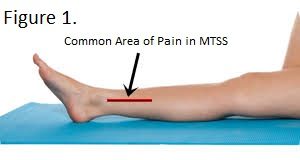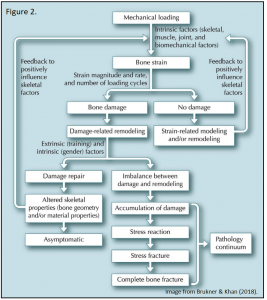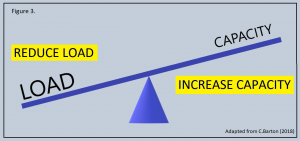Shin Splints are a common injury that collectively describes pain in your lower leg. Although most people relate to the term ‘shin splints’, it’s not a particularly useful term as there several different types of shin pain that all require different management. Arguably the two most common types of shin pain are:
- Medial tibial stress syndrome (MTSS) – Which affects the inside aspect of your shin
- Anterior compartment syndrome – Which affects the front of your shin
This blog is focusing on Medial Tibial Stress Syndrome. Stay tuned for a blog focusing on anterior compartment syndrome.
Medial Tibial Stress Syndrome
Medial tibial stress syndrome (MTSS) is the most common cause of shin pain. It is characterised by pain on the inside border of your tibia (figure 1.). It accounts for about 30% of running injuries.  What’s important to understand is that MTSS is a bone stress injury which sits upon a continuum of bone pathology.
What’s important to understand is that MTSS is a bone stress injury which sits upon a continuum of bone pathology. ![]()
How does it occur?
Whilst there are several factors related to the development of bone stress, the most common cause is an imbalance between repetitive strain and repair. This is illustrated in Figure 2 below. During a period of Mechanical loading such as running and jumping, the bone can sustain micro-damage. This is normal. In fact, it’s very helpful as it allows the bone to dissipate energy to prevent more serious damage from occurring. 
Following exercise, the body activates bone cells that remove and replace the damaged bone with new bone. This allows the bone to adapt and become more tolerant of the exercise you were performing. Happy days! In a normal situation, the bone can account for the micro-damage that has occurred, there is even a reserve of bone cells that can be called upon if needed. Where problems arise is when the mechanical loads are too high, and/or the recovery is insufficient for the bone to keep up with the rate of damage that’s occurring. The result is an accumulation of micro-damage leading to bone stress, which if not properly managed can progress into something more serious such as a stress reaction or stress fracture.
Management of MTSS
The good news is that MTSS can be effectively treated, especially if you get on to it early.
Remember, MTSS is caused by in imbalance between capacity and load (figure 3.). Therefore effective management usually involves strategies that either: Reduce or shift Load away from your shins, such as:
- Modifying training volume/intensity/running surface
- Modifying running technique to offload the shin
- Addressing footwear/orthotics
Increase your capacity to tolerate load, such as:
- Strength and conditioning programs: Calves and Gluteus Medius etc
- Addressing joint mobility/muscle tightness
- Cross training
The take-home message is if you respect medial shin pain and address it early, you’ll be able to continue training and stop it from progressing into something more serious. If your struggling with medial tibial stress syndrome, give Peak Sports Physio a call or book online for an appointment. Cheers, Todd Bird
References: Becker, J., Nakajima, M., Wu, W. (2018). Factors contributing to medial tibial stress syndrome in runners: a prospective study. Medicine and Science in Sports and Exercise, 50(10), 2092-2100. Moen, M.H., et.al. (2012). Risk factors and prognostic indicators for medial tibial stress syndrome. Scandinavian Journal of Medicine and Science in Sports. 22, 32-39 Warden, S.J., et.al (2014). Management and prevention of bone stress injuries in long-distance running. Journal of Orthopaedic and Sports Physical Therapy. 44(10), 749-765


